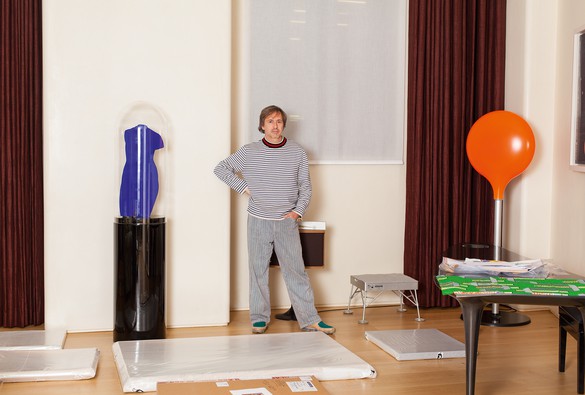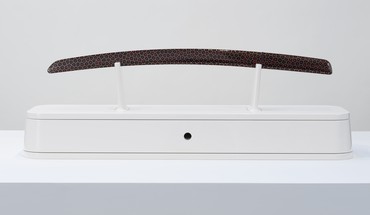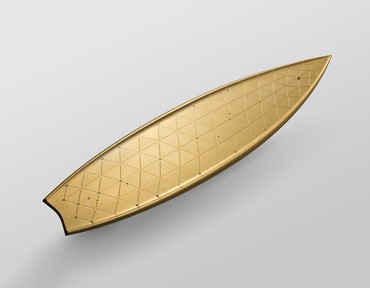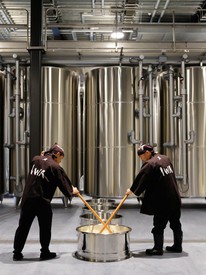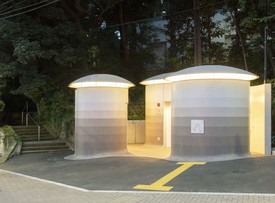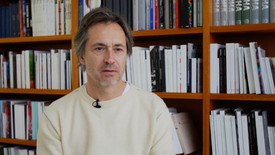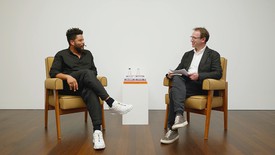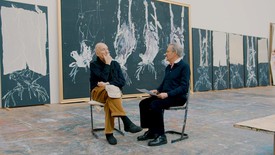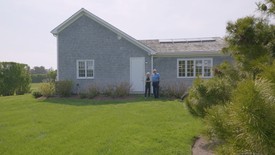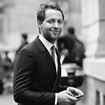
Derek Blasberg is a writer, fashion editor, and New York Times best-selling author. He has been with Gagosian since 2014, and is currently the executive editor of Gagosian Quarterly.
Derek BlasbergI was particularly excited when I saw the sword in this show. I was obsessed with Japanese swords when I was a kid, and I’d write my letters to Santa asking for one, which alarmed my parents at the time. But I’m happy to bring them to your show and say, “Look, I was just being artistic.”
Marc NewsonWhat’s incredible about this sword is the sword-maker I worked with, Hokke Saburo, is considered a national living treasure in his native Japan, and it was such a rare opportunity to work with him. It was the first time I’d done a project like that and it will probably be the last, because there’s such a small number of these people designated irreplaceable cultural icons by the government because of the level of their craft.
DBHow did the opportunity to work together come to pass?
MNIt was a silver-lining situation: I met Hokke Saburo in the aftermath of the 2011 earthquake and tsunami in Japan. A lot of craftspeople and artisans were based in the region where he lived, the Tohoku region, and their lives and work were devastated. The Japanese government created a program in which these artisans would collaborate with someone from outside their industry. A great friend of mine in Japan knew the swordsmith’s son, Hiroshi Takahashi, who happens to own a renowned digital production company called WOW, and he arranged a meeting. I was so thrilled to be able to work with this guy because not only was it a once-in-a-lifetime opportunity but he was nearing the end of his career, he’s very old now, so I jumped at the chance.
DBYou go to Japan often, right?
MNI’ve been traveling to Japan frequently for the last thirty years. In fact I’d visited different sword-makers once before, and I’d worked with other national living treasures in other industries. So I had some experience. I absolutely knew how revered these people are, and I know Japan pretty well for a foreigner. This was right up my alley. Am I talking too much about this sword?
DBNo, I’m still into swords! Santa never brought me one!
MNI was struggling to understand how my obsession with this man’s work could inform my own. You know, it’s all very well to do a project like this, but then how do you make it relevant in a contemporary forum? This was exactly the same problem that Hokke Saburo faced. One of the hurdles that these craftspeople in Japan have to overcome is, Why do people want to own this stuff now? Fewer and fewer people are buying these extraordinary works. So the idea occurred to me that I should include a piece in an exhibition, because that would create a forum for people to see this piece in an environment where it wouldn’t normally be seen, a gallery context.
There was also the possibility that this could prove to be something that would sustain this sword-maker commercially through a few more years, which I was really keen to do too. Japan faces the same problems that we do in the West, where these sorts of crafts and skills are slowly dying out. The work I’m doing for the exhibition is largely about engaging these sorts of skill sets that are quite rare and obscure.
DBMoving on from the sword, there are other works in the show, including a desk and a lounge. Did those ideas come to you in Japan too?
MNThe lion’s share of the work in the show is furniture related, which is of course typical for what I do. You can divide the work into two groups: first, pieces in cast glass, on a very large scale rarely executed in that medium—in fact no one’s ever made pieces this big in glass before. They’re sort of mind-bogglingly huge, which is something I’d wanted to do for a very, very long time. They were made in the Czech Republic but they’re inspired by artisanal techniques pioneered in Venice. There’s one factory that can do this, literally, in the world, it’s that obscure.
Then there’s another body of work in cloisonné enamel, also large, and sort of half sculpture, half furniture. Cloisonné is a type of enamel a little like what you’d see in a Fabergé egg, glass enamel in intricate colors. But these pieces are enormous too, probably the biggest cloisonné pieces you’ll ever see. As with the glass, there’s only one part of the world where this can be done and that’s Beijing, the home of cloisonné enamel. Although “cloisonné” is obviously a French word, the technique was invented in China many hundreds of years ago, and I went there and searched around for someone who could execute on this scale. It’s taken me five or six years to identify a factory, get to know them, and reinvigorate the factory. The process of cloisonné enamel involves firing in a giant kiln, in the same way as the glass in the Czech Republic. They share this process; big cast pieces fired in a giant oven. In Beijing, we had to build an oven the size of a small garage. You literally could drive a car in there.
DBWas this process something you sought out?
MNI trained as a jeweler and a silversmith, I never went to design school, so this is a little bit like going back to my roots as a jeweler, but on a whole other scale. It takes thousands of hours to produce one of these pieces. Look at the detail on some of the cloisonné works. You might have seen a cloisonné pot six inches high, but these are massive.
DBWhat appeals to you about the process?
MNWhen you were a kid, did you have to take a crafts class at school where you’d make a little enamel brooch? Or was that just a ’70s thing?
DBI did not! But if I’d known I could have been the next Marc Newson, I would happily have done more crafts in school.
MNIt’s an incredibly detailed mosaic of complicated visual forms. Outside of that, you apply the boundaries for the enamel and you fill each one of these little shapes that you create; it might be a flower or a little symbol, but there are thousands of these shapes applied by hand by these little old women. You have to see it to understand it. The only place they could do this is somewhere like China, where they have the aptitude to do it, but not only that, it’s something they’ve been doing for centuries. The amount of detail—you scratch your head and just think, “Oh, my God.” Just like back in school, these are very craft-oriented kinds of things and they’re deeply decorative, which is not something people would necessarily associate with my work.
DBThis is the first exhibition of new furniture from you in over a decade. Why now?
MNHonestly, I didn’t think it would take this long. I’d planned to have a show about four years ago, but for better or worse I ended up choosing a couple of mediums that were just so challenging. The good news is they’re impossible to copy or replicate; but the bad news is, it’s taken me three or four years to get it together and even find these places. I love doing exotic things, and I like pushing the boundaries of techniques, technologies. I love doing things that challenge the process. The two factories, the one in the Czech Republic and the one in China—these guys are used to doing the biggest and most ambitious things in their respective areas, but they’d never done anything like this. They make things for the Chinese government and they’re kind of scratching their heads, going, “How are we going to do this?” That’s inspirational for me: finding techniques that push the boundaries of what’s possible.
DBSo it took a little longer than planned, but we’re happy it happened eventually.
MNI don’t feel pressure to have shows for the sake of having shows. It’s got to be meaningful for me and I needed to find some really, really compelling processes to use. Having said that, I sincerely hope the next show doesn’t take the same amount of time! In a way, I kind of bit off more than I could chew, thinking I could nail it a few years earlier than I did. It’s got to be right. I just waited until I was happy and got it right.
DBLastly, there’s a familiar character in this show: the surfboard, which you’ve done before.
MNThere will always be these themes that run throughout. I did a surfboard ten years ago for a guy called Garrett McNamara, this crazy surfer who at the time was just becoming known as the guy who surfed the biggest waves in the world. He held the world record for surfing the most giant wave. Now, ten years later, he’s extremely established and probably on the verge of big-wave retirement, so I wanted to do another one of these crazy surfboards for him because we developed this relationship and it was nice to follow it through. He surfed the board in this show at a place called Nazaré on the coast of Portugal, this crazy, biblical spot where a couple of times a year these waves come in that are about ninety feet tall. I guess it’s like surfing down the side of a high-rise. I couldn’t imagine how anyone could do it, but he’s the most renowned tow-in surfer who does this and I couldn’t have found a better person to try it out.
DBThat’s a true testament to art and function, presumably.
MNYeah, it is. What I love is the idea that you take something out of its context, like a surfboard, and reposition it. I grew up in Australia, so surfing has always been part of my life, it’s a sort of subculture where I came from, but I’m not really a surfer, I was never passionate about doing it myself. But I love taking it out of its normal context and putting it into an art gallery, into the context of a place where new eyes will see it. When I did it the first time, it went down well. It ended up being a very popular piece, which I thought was quite surprising. I figured I’d do that again and it would be the last time I’d do it, because it’s very much about the relationship that I’ve developed with Garrett.
What I love is the idea that you take something out of its context, like a surfboard, and reposition it.
Marc Newson
DBHe sounds bonkers. I read that he broke the world surfing record on an over-100-foot wave.
MNYep. He has the biggest balls in history. He is completely, utterly fearless. Now he’s in his forties, which is getting quite old from the point of view of big-wave self-preservation. He’s had some terrible accidents—he told me once how many stitches he’d had and it was in the thousands, from falling off surfboards into reefs and crazy stuff like that. But he’s a sweet, lovely, and generous guy! He just has a slightly different genetic makeup from the rest of us. He lacks certain genes, like fear.
DBA sword and a surfboard. What else do you need?
MNI wanted to keep the show coherent and tight. Though all these things sound different, when you see them all in the same place they’re all quite functional and specific. They’re beautiful objects that few people who acquire these things will ever use for what they’re intended for, but there’s a beauty in that. There’s an underlying functional quality but the surfboards could end up being wall hangings, and that would be cool too.
Artwork © Marc Newson; Marc Newson, Gagosian, New York, January 17–February 20, 2019; Marc Newson, Gagosian, Hong Kong, May 23–July 27, 2019
